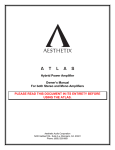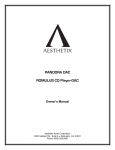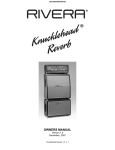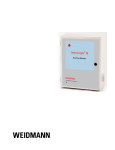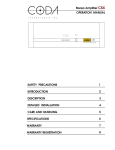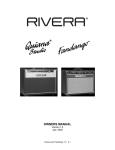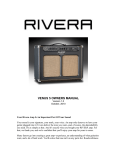Download Aesthetix Janus Owner`s manual
Transcript
Janus PREAMPLIFIER OWNER'S MANUAL Aesthetix Audio Corporation 5220 Gabbert Rd., Suite A ♦ Moorpark, CA. 93021 Phone: (805) 529-9901 INTRODUCTION Thank you for purchasing the Janus preamplifier. The Janus is a groundbreaking audio component which combines sonic quality, innovative features and build quality with lineage directly traceable to the reference Callisto line stage and Io phono stage. Janus contains solid state circuitry but all of its amplification is achieved using vacuum tubes. The output stage is a vacuum tube based differential driver. There is no global feedback used in the Janus whatsoever. Janus’ advanced microprocessor-based control circuitry is completely inactive when not in use i.e. when not receiving a command from the user, resulting in no ill effects on sound quality. The unit contains innovative features, such as a switched resistor volume control, theater bypass mode, phase inversion and others. The massive power supply consists of a high voltage transformer, heater transformer, and high voltage choke. All of the magnetic components are shielded by a stainless steel transformer cover, which also performs double duty as a structural truss. The high voltage power supply is regulated with a discrete transistor-based regulator. The low voltage solid state power supplies are discretely regulated. Only the highest quality components are used in the Janus, including Roederstein resistors, RelCap film capacitors, Mercury Magnetics transformers and Nichicon audio grade electrolytic capacitors. We hope you enjoy many years of music using the Janus preamplifier. PLACEMENT Janus should be located away from possible sources of hum such as power cords, power transformers and the like. Ventilation is critical for reliability. It should not be located on top of any heat source such as a power amplifier. If it is positioned within an enclosed space then fans may be warranted. All air vents must remain unobstructed. A minimum of 3 inches of space above the unit is required. 2 CONNECTIONS Important: Ensure the rear panel power switch is in the off position whenever changing connections. Also ensure that the power amplifier is off. 1) Connect one or more source components to the Janus' inputs. Both balanced and singleended connections are provided for each input. A tape deck may be connected to the tape input / output connectors. The tape output is unbuffered. 2) A turntable may be connected to the phono inputs. Never connect a high level source component, such as a CD player or tuner, to the phono inputs. Damage may result. 3) Using either the single-ended (RCA) or balanced (XLR) outputs, connect the Janus to your power amplifier. Use of balanced connections will yield 6dB more gain. 4) Connect the supplied IEC power cord to the back of the Janus and to an unswitched, grounded AC outlet. Line conditioners may be used with the unit if desired. Ensure the maximum power of the conditioner is not being exceeded. Note: The line level input circuitry of the Janus accepts a maximum input voltage of 3.5v rms single-ended or 7v rms balanced. This is well above the industry standard 2v rms single-ended or 4v rms balanced. However, there are a few source components that exceed this limit. If the offending source component has a volume or gain control, all that is necessary is to reduce the gain or volume of the source component. In other cases, it will be necessary to have the source component modified to be within industry standard specifications. A clear indication that this limit is being exceeded is a raspy distortion or compression of musical peaks. OPERATION STANDBY AC power is applied to the unit by pressing on the left side of the power switch, when viewed from the front of the unit. When Janus has power applied for the first time, it will first display the installed software version on the LED display for two seconds, then automatically enter the standby mode. While in standby, power is applied to all circuits except the vacuum tube heaters. The high voltage supply is reduced to a level that is safe for the vacuum tubes. All solid state circuitry in the Janus remains powered. Anytime Janus is in standby, the standby light will be illuminated. Pressing the standby button will take Janus out of standby. The standby light will blink for 30 seconds, during which time the heater supplies will be energized and the high voltage supply will rise to operational levels. After the warm-up period, the standby light will extinguish and the input will be displayed, and the mute light will be illuminated indicating the Janus is muted. Place Janus in standby when not in use. 3 INPUT SELECTION Press any of the five input selection buttons to select the desired input. Tape input selection will monitor the output from a cassette deck. Press PHONO to select the high gain phono preamplifier. VOLUME Volume is controlled by pressing the left side of the display glass for down, the right side for up. Each step is 1dB. BALANCE Balance is adjusted only by the remote control, by the left and right arrow buttons. It is not adjustable from the front panel. When the unit is adjusted to be out of balance, two volume numbers will display. The left indicates the left channel volume number, the right indicates the right channel volume number. When both channels are set to the same number, the display will change to only show one number. The balance will shift up to 9 steps in either direction and the 10th step will be off, indicated by 00. MUTE Pressing the mute button will alternately mute or unmute the unit. When the mute light is illuminated, the Janus is muted. When muted, the volume is internally set to zero and the output is shorted to ground. BYPASS Bypass is used to set the unit to unity gain (meaning it does not provide any gain or loss). This is used when a home theater processor is connected to the Janus, and system control is delegated entirely to the processor. Extreme caution is necessary, as setting the Janus to unity gain will, in most system, allow the full input level to reach the power amplifier. This can damage speakers. One or more inputs may be configured for bypass. Once configured for bypass, that input will automatically go into bypass mode every time it is selected. Once in bypass mode, there is no volume display or function and mute is non-functional. Follow these steps to configure an input for bypass: 1) Select desired input. 2) On the front panel only (not remote control), depress the bypass button and hold it in the depressed position. The bypass LED will light. 3) While holding the bypass button, press the input button again. Both the bypass and selected input LEDs will blink rapidly, indicating the unit recognized the desired bypass configuration. The unit will enter bypass mode as indicated by the bypass LED and lack of volume display. Selecting another input that has not been configured for bypass will exit the bypass mode. 4 Selecting an input that is configured for bypass will cause the bypass LED to blink for a short time before going to the desired input, indicating that the unit is about to enter the bypass mode. This is to allow the user time to reduce the level of the surround processor or select another input if there is any doubt about the safety of entering bypass mode. Pressing any button on the Janus while the bypass LED is blinking will cause the unit to revert back to the last selected input. To remove the bypass configuration for a selected input, follow the same procedure as above. The tape input may also be configured for bypass. The procedure is the same as above, except holding the tape input button instead of the currently selected input. Tape must be pre-selected. A special feature of using the tape input as the bypass input is that high quality analog sources can be kept in their purest form for two channel listening through the Janus, or routed through the surround processor when desired, by selecting tape. The tape output of the Janus, in that case, should be routed to an input of the surround processor. Bypass configurations are stored in memory and are retained even if power is removed. For this reason, it is recommended to remove all bypass configurations if the unit is ever transferred from one system to another, to prevent possible system damage. PHASE The phase button is used to change the absolute phase of the output. When the phase LED is illuminated, the output is 180 degrees out of phase relative to the input. When the LED is off, the output is 0 degrees. The correct setting is that which yields the best focus of image and tightest bass. It will vary from recording to recording, as absolute phase is rarely maintained throughout the recording and mastering process. DISPLAY In normal operation, the level setting is displayed and various indicator lights will be illuminated. When the display button is pressed, all lights will extinguish. Pressing any button will turn on the display and indicator lights for 5 seconds, and then extinguish. The only exception is standby, which will always have the standby light illuminated. Pressing the display button while the display is off, or during the 5 second timeout period, will turn on the display and normal operation will return. Note: The LED for the display button is intentionally inactive. GAIN ADJUSTMENT Pressing the gain button will show the gain for the phono section. Press the right side of the display glass to increase the gain, and the left side of the glass to decrease the gain. The gain displayed is in dB and is the gain attained when the unit is new with factory supplied tubes. A unit with aged tubes, or non-factory tubes (shame on you!), may not achieve these gain values. 5 It is possible for the phono section to overload the line section. Distortion on peaks is the most obvious indication, but sometimes it can be a less obvious compression of dynamics and an upper midrange hardness. Simply lowering the gain of the phono section will eliminate this problem. The selected gain is stored in non-volatile memory and will therefore not be lost even if the power is disconnected. The mute button is active while in the gain adjustment mode. The below chart shows the recommended gain settings by cartridge output level. These recommendations will produce the best signal-to-noise ratio and lowest distortion. It is advised to try one setting above and below the recommended value to determine the best setting for your system. Cartridge output level (millivolts) Less than .2 .2 - .5 .6 - 1 1.1 - 2 2.1 - 5 5.1 - 7 Recommended Gain Setting 75dB 62dB 56dB 50dB 44dB 38dB LOADING ADJUSTMENT Pressing the load button will show the loading for the phono section. Press the right side of the display glass to decrease the loading (increased ohms), and the left side of the glass to increase it (decreased ohms). The loading displayed is in ohms, and an H on the display indicates kilo ohms. The correct loading will be achieved when music has the right balance of dynamics, high frequency extension and lack of glare or brightness. Generally speaking, less loading (higher ohms) results in more high frequencies and more dynamics but can be too bright with some cartridges. More loading (lower ohms) can reduce brightness but if overdone can result in reduced dynamics and a dull, lifeless quality. Consult your dealer for loading recommendations on the cartridge(s) you are using. The selected load setting is stored in non-volatile memory and will therefore not be lost even if the power is disconnected. The mute button is active while in the loading adjustment mode. DEMAGNETIZER Important note: Do not use the demagnetizer with a moving magnet (MM) cartridge. Damage to the cartridge will occur. Pressing the demag button will activate the cartridge demagnetizer for phono section. The demag light will illuminate, the output will be muted and the demagnetizing signal will be applied to the cartridge. When the demagnetizing cycle is complete, the demag light will extinguish and normal operation will return. No buttons are active while demagnetizing. 6 Moving Coil cartridges should be demagnetized weekly or anytime a muddiness or lack of clarity becomes apparent. When not in use, the demagnetizer is fully deactivated. No power is applied to its circuits and the output is disconnected from the cartridges by a relay. Advanced display functionality This unit contains the ability to sense the ambient light level in the room and adjust the display and LEDs accordingly. While the factory settings will work for most situations, there may be times when adjustment to the settings is useful. There are three main sections to the advanced display functionality: Adjustment of display brightness Adjustment of LED brightness Restoration of the factory default settings Adjustment of display brightness: To access this section, first press and hold the “display” button, then concurrently press “1” button. This can only be done from the front panel. It is recommended that once this section is entered, that all adjustments be made with the remote at some distance from the unit, so as not to obstruct light from reaching the sensor. LED #2 will light, and the display will show two numbers in the range 00-15, one on the left display and one on the right display. The left number indicates the light level that the sensor is reporting, 0 is darkest and 15 is brightest. The rightmost number indicates the display brightness setting for that light level, 0 is darkest and 15 is brightest. LED#2 will be lit, which indicates that pressing the “up” or “down” buttons will adjust the display brightness for the current light level. Pressing button #1 will turn on LED#1, which indicates that pressing the “up” or “down” buttons will change to a different light level setting, for which the display brightness could then be changed by pressing button #2. Changes to the display brightness will only be visible for the current light level. To exit this section, press the “display” button. Adjustment of LED brightness: This section works identically to the above “Adjustment of display brightness” except that adjustment is made to the LED brightness instead of the display. To access this section, first press and hold the “display” button, then concurrently press “2” button. This can only be done from the front panel. It is recommended that once this section is entered, that all adjustments be made with the remote at some distance from the unit, so as not to obstruct light from reaching the sensor. LED #2 will light, and the display will show two numbers in the range 00-15, one on the left display and one on the right display. The left number 7 indicates the light level that the sensor is reporting, 0 is darkest and 15 is brightest. The rightmost number indicates the LED brightness setting for that light level, 0 is darkest and 15 is brightest. LED#2 will be lit, which indicates that pressing the “up” or “down” buttons will adjust the LED brightness for the current light level. Pressing button #1 will turn on LED#1, which indicates that pressing the “up” or “down” buttons will change to a different light level setting, for which the LED brightness could then be changed by pressing button #2. Changes to the LED brightness will only be visible for the current light level. To exit this section, press the “display” button. Special note: Setting all brightness levels to the same value, for all light levels, will result in no change of display or LED brightness with changes in ambient light level in the room. Restoration of the factory default settings: To restore the factory settings for all display settings, first press and hold the “display” button, then concurrently press “3” button. This can only be done from the front panel. LEDs 1-5 will light, indicating that the unit has restored the factory settings. Maintenance Do not, under any condition, remove the top cover while the AC power cord is connected to the unit. As the power supply remains charged even with power removed, wait at least 20 minutes after removing the AC power cord before attempting any maintenance. Under normal conditions, internal access is not required. In the event of a noisy tube or other maintenance, the top cover may be removed. There are no screws, it is securely held in place by an interlocking material. To remove the top cover, grasp it at the rear left edge and pull up firmly. The interlocking material will gradually disengage as the top cover is “peeled” up. To reinstall the top cover, align the front edge with the back of the faceplate and gradually press down, starting at the front and moving toward the back. 8 Specifications Fuses: External fuse (in IEC power connector) 2 amp slow blow (117v) 1 amp slow blow (230v) Spare fuse included in IEC power connector. Tubes: Phono Section V1 & V2 V3 V4 E83CCS or 12AX7LP E83CCS or 12AX7WB 6922 (6DJ8) Line Section V1 V2 E83CCS or 12AX7WB 6922 (6DJ8) Power Consumption: Standby: Active: 20 watts 120 watts Dimensions: 18" Width x 17 5/8" Depth x 4 3/8" Height Shipping Weight: 40 lbs (18.2 Kg) 9 90 DAY LIMITED WARRANTY TERMS AND CONDITIONS (3 Year optional extended service contract) 1. Aesthetix warrants the product designated herein to be free of manufacturing defects in material and workmanship, subject to the conditions herein set forth, for a period of 90 days from the date of purchase by the original purchaser. If the purchaser registers the unit with Aesthetix by mailing in the warranty card, together with a copy of the bill of sale, within 14 days of the date of purchase, said purchaser will be registered for an extended service contract. The extended service contract extends the 90 days to a period of 3 years from the date of purchase by the original purchaser or no later than 4 years from the date of shipment to the authorized Aesthetix dealer, whichever comes first. The warranty period for factory tubes does not get extended and therefore remains at 90 days. 2. CONDITIONS This warranty is subject to the following conditions and limitations. The warranty is void and inapplicable if the product has been used or handled other than in accordance with the instructions in the owner's manual, abused or misused, damaged by accident or neglect or in being transported, or the defect is due to the product being repaired or tampered with or modified by anyone other than Aesthetix. The product must be packed and returned to Aesthetix by the customer at his or her sole expense. A returned product must be accompanied by a written description of the defect and a photocopy of the original purchase receipt. This receipt must clearly list model and serial number, the date of purchase, the name and address of the purchaser and authorized dealer and the purchase price. Aesthetix reserves the right to modify the design of any product without obligation to purchasers of previously manufactured products and to change the prices or specifications of any product without notice or obligation to any person. 3. REMEDY In the event the above product fails to meet the warranty, and the above conditions have been met, the purchaser's sole remedy under the limited warranty shall be to return the product to Aesthetix where the defect will be rectified without charge for parts or labor. 4. LIMITED TO ORIGINAL PURCHASER This warranty is for the sole benefit of the original purchaser of the covered product and shall not be transferred to a subsequent purchaser of the product. 5. DURATION OF WARRANTY This warranty expires 90 days after the date of original purchase. If Aesthetix receives the warranty registration card, this period is extended to the third anniversary of the date of purchase or no later that the fourth anniversary of the shipment to the authorized Aesthetix dealer, whichever comes first. The warranty period for factory tubes does not get extended and therefore remains at 90 days. 6. MISCELLANEOUS ANY IMPLIED WARRANTIES RELATING TO THE ABOVE PRODUCT SHALL BE LIMITED TO THE DURATION OF THIS WARRANTY. THE WARRANTY DOES NOT EXTEND TO ANY INCIDENTAL OR CONSEQUENTIAL COSTS OR DAMAGES TO THE PURCHASER. Some states do not allow limitations on how long an implied warranty lasts or an exclusion or limitation of incidental or consequential damages, so the above limitations or exclusions may not apply to you. This Warranty gives you specific legal rights, and you may also have other rights which vary from state to state. 7. WARRANTY OUTSIDE THE USA Aesthetix has formal distribution in many of the countries of the free world, in each country the Aesthetix importer has contractually accepted the responsibility for product warranty. Warranty should normally be obtained from the importing dealer or distributor from whom you obtain your product. Rev 1.06 4-8-18











